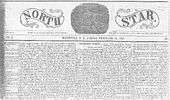The North Star (anti-slavery newspaper)


- For other newspapers named North Star, see North Star (disambiguation)#Newspapers
The North Star was a nineteenth-century anti-slavery newspaper published from the Talman Building in Rochester, New York by abolitionist Frederick Douglass.[1] The paper commenced publication on December 3, 1847 and ceased as the The North Star in June 1851 when it merged with Gerrit Smith's Liberty Party Paper (based in Syracuse, New York) to form Frederick Douglass' Paper.[2] The North Star's slogan was "Right is of no Sex—Truth is of no Color—God is the Father of us all, and all we are Brethren."[3]
Inspiration
In 1845, Frederick Douglass was first inspired to publish The North Star after subscribing to The Liberator, a weekly newspaper published by William Lloyd Garrison. The Liberator was a newspaper established by Garrison and his supporters founded upon moral principles.[2] The North Star title was a reference to the directions given to runaway slaves trying to reach the Northern states and Canada: Follow the North Star.[4] Published weekly, The North Star was four pages long and sold by subscription at the cost of $2 per year to more than 4,000 readers in the United States, Europe, and the West Indies. The first of its four pages focused on current events concerning abolitionist issues.[5]
The Garrisonian Liberator was founded upon the notion that the Constitution was fundamentally pro-slavery and that the Union ought to be dissolved. Douglass disagreed but supported the nonviolent approach to the emancipation of slaves by education and moral suasion.[6] Under the guidance of the abolitionist society, Douglass became well acquainted with the pursuit of the emancipation of slaves through a New England religious perspective.[7] Garrison had earlier convinced the Massachusetts Anti-Slavery Society to hire Douglass as an agent, touring with Garrison and telling audiences about his experiences in slavery. Douglass worked with another abolitionist, Martin R. Delany, who traveled to lecture, report, and generate subscriptions to The North Star.[4]
Editorial perspective and breadth
Douglass's thoughts toward political inaction changed when he attended the National Convention of Colored Citizens, an antislavery convention in Buffalo, New York, in August 1843. One of the many speakers present at the convention was Henry Highland Garnet. Formerly a slave in Maryland, Garnet was a Presbyterian minister who supported violent action against slaveholders. Garnet's demands of independent action addressed to the American slaves remained one of the leading issues of change for Douglass.
During a nineteen-month stay in Britain and Ireland, several of Douglass’ supporters bought his freedom and assisted with the purchase of a printing press. With this assistance Douglass was determined to begin an African-American newspaper that would engage the anti-slavery movement politically. On his return to the United States in March 1847, Douglass shared his ideas of The North Star with his mentors. Ignoring the advice of the American Anti-Slavery Society, Douglass moved to Rochester, New York to publish the first edition. When questioned on his decision to create The North Star, Douglass is said to have responded,
"I still see before me a life of toil and trials..., but, justice must be done, the truth must be told...I will not be silent."[8]
In covering politics in Europe, literature, slavery in the United States, and culture generally in both The North Star and Frederick Douglass' Paper, Douglass achieved an unconstrained independence to write freely on topics from the California Gold Rush to Uncle Tom's Cabin to Charles Dickens's Bleak House.[9]
See also
References
- ↑ "Retrofitting Rochester: Talman Building". Rochester Democrat and Chronicle. Retrieved 2016-05-25.
- 1 2 David B. Chesebrough, Frederick Douglass; Oratory from Slavery, (Connecticut: Greenwood Press, 1998), 16-18.
- ↑ "The North Star (Reason): American Treasures of the library of Congress". http://www.loc.gov/exhibits/treasures/trr085.html. External link in
|website=(help); - 1 2 ""Abolitionist Movement." History Net: Where History Comes Alive.". http://www.historynet.com/abolitionist-movement. External link in
|website=(help); - ↑ "The North Star (American Newspaper) --Encyclopedia Britannica". http://www.britannica.com/EBchecked/topic/852011/The-North-Star. External link in
|website=(help); - ↑ William S. McFeely, Frederick Douglass (New York: W.W. Norton and Company, 1991), 84-206.
- ↑ William S. McFeely, Frederick Douglass (New York: W.W. Norton and Company, 1991), 15-16.
- ↑ William S. McFeely, Frederick Douglass (New York: W.W. Norton and Company, 1991), 146-147.
- ↑ Janet Neary and Hollis Robbins, “African American Literature of the Gold Rush,” Mapping Region in Early American Writing. Eds. Edward Watts, Keri Holt, and John Funchion. Athens: University of Georgia Press (2015)
Bibliography
- Ira Berlin, "Who Freed the Slaves; Emancipation and Its Meaning", in Blight and Simpson ed. Union and Emancipation; Essays on Politics and Race in the Civil War Era (Kent, Kent State University Press, 1234), p121.
External links
- The North Star, The North Star: Complete December 3, 1847–April 17, 1851, Accessible Archives (subscription required).
- The North Star, The North Star: Online Collection, Lavery Library, St. John Fisher College (selected issues only).
- "Our Paper and Its Prospects", The North Star, December 3, 1847.
